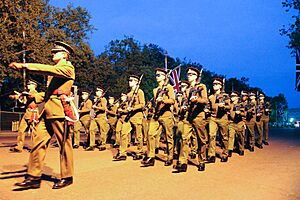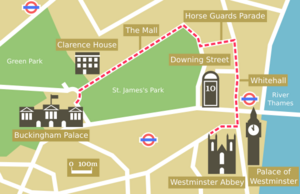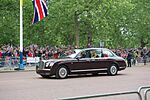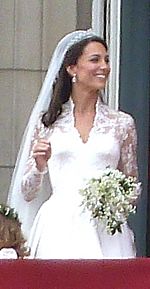Wedding of Prince William and Catherine Middleton facts for kids

William and Catherine waving to the crowd at The Mall shortly after their wedding
|
|
| Date | 29 April 2011 |
|---|---|
| Venue | Westminster Abbey |
| Location | London, England |
| Participants | Prince William Catherine Middleton |
The wedding of Prince William and Catherine Middleton happened on Friday, 29 April 2011. It took place at Westminster Abbey in London, England. At the time, William was second in line to become the British King. The couple had been together since 2003.
Many important people were part of the ceremony. John Hall, the Dean of Westminster, led the service. Rowan Williams, the Archbishop of Canterbury, performed the marriage. Richard Chartres, the Bishop of London, gave a speech. Catherine's brother, James Middleton, also gave a reading.
Prince Harry was William's best man. Catherine's sister, Pippa, was the maid of honour. Family members, foreign royals, and special guests attended. After the ceremony, William and Catherine waved from the Buckingham Palace balcony. This wedding was not a full state event. So, the couple chose many details, including the guest list of about 1,900 people.
William and Catherine first met in 2001. They announced their engagement on 16 November 2010. The wedding created a lot of excitement in the news. Many people compared it to the wedding of William's parents in 1981. The wedding day was a public holiday in the United Kingdom. It included many royal traditions, like using state carriages. Soldiers from the Foot Guards and Household Cavalry also played a role.
People across the Commonwealth celebrated the wedding. Over 5,000 street parties took place in the UK. About a million people lined the route in London. Tens of millions more watched live around the world. This included 72 million live streams on YouTube. In the UK, over 36 million people watched some part of the TV coverage.
The Engagement News
Prince William and Catherine Middleton met in 2001. They were both studying at the University of St Andrews. They started dating in 2003. On 16 November 2010, Clarence House announced their engagement. They got engaged in October 2010 during a trip to Kenya. William gave Catherine the same engagement ring his father gave to his mother, Diana, Princess of Wales. It is an 18-karat white gold ring with a blue sapphire and 14 diamonds. After their wedding, they planned to live on the Isle of Anglesey in Wales. William was working there with the Royal Air Force.
The Queen was "absolutely delighted" about the engagement. She gave her official permission for the marriage. This was required by an old law. Many leaders, including prime ministers, sent their congratulations.
After the announcement, William and Catherine gave an interview. They also had official engagement photos taken. These photos were taken by Mario Testino on 25 November at St. James's Palace.
On 23 November 2010, the wedding date was set for Friday, 29 April 2011. The Queen ordered that the wedding day would be a public holiday in the UK. It was also a holiday in several British Overseas Territories and Crown Dependencies.
Catherine, who was christened as a child, decided to be confirmed into the Church of England. This service took place on 10 March at St James's Palace. Her family and William were there. TV shows about the couple's story also aired before the wedding.
Planning the Big Day
On 5 January, it was announced that the ceremony would start at 11:00 AM. Catherine would arrive at the abbey by car, not by carriage. This was a break from tradition for royal brides. The route went along The Mall, through Horse Guards Parade, and down Whitehall. Some roads in central London were closed for the event.
Wedding Costs
The Royal Family and the Middletons paid for the wedding itself. The government covered security and transport costs. The couple asked for donations to charities instead of wedding gifts. They set up a special fund for this. It helped charities like the New Zealand Christchurch Earthquake Appeal. It also supported the Canadian Coast Guard Auxiliary and the Royal Flying Doctor Service.
The total cost of the event was about £23.7 million. Security alone was estimated at A$32 million. Some experts thought the public holiday would boost tourism. However, past royal weddings had not always increased visitors.
Guest List
Three different guest lists were sent out. About 1,900 people attended the ceremony at the abbey. Around 600 guests were invited to a lunch at Buckingham Palace. The Queen hosted this reception. Finally, about 300 people attended an evening dinner. The Prince of Wales hosted this last event.
More than half of the guests were family and friends. The lists also included leaders from the Commonwealth. Religious figures, diplomats, and military officials were invited too. Members of foreign royal families and William's charity representatives also attended.
The Royal Route
William's journey to the ceremony started at Buckingham Palace. He traveled along The Mall, past Clarence House, and through Whitehall. After the ceremony, the newly married couple returned along the same route by carriage. Roads around the route were closed early in the morning. Guests started arriving at the abbey from 8:15 AM.
William and Harry left Clarence House at 10:10 AM. They arrived at the abbey in a Bentley State Limousine. Other royal families and the Middleton family followed. The Queen and Prince Philip arrived last, as is tradition. Catherine left the Goring Hotel at 10:52 AM in a Rolls-Royce Phantom VI. The service began at 11:00 AM.
The service ended at 12:15 PM. William and Catherine then rode to Buckingham Palace in the 1902 State Landau. They were followed by the bridal party and other family members in carriages. At 1:25 PM, the couple appeared on the Buckingham Palace balcony. They watched a flypast of historic and modern aircraft.
The Ceremony
The Venue: Westminster Abbey

Westminster Abbey was founded in AD 960. It is a very special church. It has been the place for coronations since 1066. In the 20th century, it became popular for royal weddings. Before 1918, most royal weddings were in royal chapels. The abbey can seat 2000 people. It has hosted many royal weddings in the last century. This includes William's grandparents, Queen Elizabeth II and Prince Philip, in 1947. It was also where William's aunt, Princess Anne, married in 1973. The abbey was also the setting for the funeral of Diana, Princess of Wales, in 1997. For the wedding, 20-foot tall trees decorated the main aisle.
The Bridal Party
William chose his brother, Prince Harry, as his best man. This was a break from old royal tradition. Catherine chose her sister, Pippa, as her maid of honour. There were four bridesmaids and two page boys:
- Lady Louise Mountbatten-Windsor, age seven, daughter of the Prince Edward, Earl of Wessex.
- Margarita Armstrong-Jones, age eight, daughter of David Armstrong-Jones, Viscount Linley.
- Grace van Cutsem, age three, a friend's daughter.
- Eliza Lopes, age three, granddaughter of Camilla, Duchess of Cornwall.
- William Lowther-Pinkerton, age ten, son of William's private secretary.
- Tom Pettifer, age eight, son of William and Harry's former nanny.
Wedding Outfits
The Bride's Dress
Catherine's wedding dress was designed by Sarah Burton at Alexander McQueen. It was made of ivory satin. It had a long-sleeved lace top and a full skirt. The back had a nine-foot train. The lace had flowers like roses, thistles, daffodils, and shamrocks. These represented England, Scotland, Wales, and Northern Ireland.
The Cartier Halo Tiara held her veil. The Queen lent her this tiara, which was made in 1936. It was bought by the Queen's father for his wife. Princess Elizabeth (later Queen Elizabeth II) received it on her 18th birthday. Catherine's stylists made sure the tiara stayed in place.
For the tradition of "something old, something new, something borrowed, something blue":
- Her dress and veil had old lace.
- Her parents gave her new diamond earrings.
- The Queen's tiara was borrowed.
- A blue ribbon was sewn into the dress.
Catherine's shoes matched her dress. Her bouquet had myrtle, lily of the valley, and sweet William. Catherine did her own makeup for the wedding. Her hair was styled in loose curls.
Bridal Attendants' Outfits
Pippa Middleton's dress was also by Sarah Burton. It was made of ivory satin and matched Catherine's dress. Her hair was styled with ivy and lily of the valley.
The young bridesmaids wore dresses designed by Nicki Macfarlane. They were handmade and echoed Catherine's dress. Their hair wreaths were inspired by Catherine's mother's headdress from her own wedding. The bridesmaids wore satin Mary Jane shoes. Their flowers matched Catherine's bouquet.
The pageboys wore outfits like a "Foot Guard officer" from the 1820s. Their tunics were red with gold trim. They had Irish shamrocks on the collars.
Groom and Best Man's Uniforms
Prince William wore the full dress uniform of the Irish Guards. He was the Colonel of that regiment. He wore his Order of the Garter star and blue ribbon. His RAF wings and Golden Jubilee Medal were also on his uniform.
Prince Harry wore the uniform of a captain of the Blues and Royals. He wore his Army Air Corps wings and medals. Designers worked with the Princes to make their outfits comfortable. They even added a small pocket to Harry's uniform for Catherine's wedding ring.
The Wedding Service
The service was based on a traditional form. The Dean of Westminster, John Hall, led most of it. Rowan Williams, the Archbishop of Canterbury, performed the marriage. Richard Chartres, the Bishop of London, gave the sermon. It is a long tradition for the Archbishop of Canterbury to marry future monarchs.
The service began with the Queen's procession. Soon after, Catherine arrived with her father. As the choir sang "I was glad", Catherine walked down the aisle to meet William. The service included hymns, fanfares, and music.
In their marriage vows, the couple promised to "love, comfort, honour and keep" each other. They exchanged a single ring.
Catherine's brother, James Middleton, read a passage from the Epistle to the Romans. This reading encouraged living a good and peaceful life.
The Bishop of London's sermon urged the couple to live selflessly. He ended with a prayer written by William and Catherine themselves.
After signing the registers, William and Catherine walked down the aisle. They bowed and curtsied to the Queen. They were followed by their bridal party and families.
Leaving Westminster Abbey, they were greeted by cheers. They rode in the 1902 State Landau carriage. Other carriages carried the bridal party and royal family.
Catherine's wedding bouquet was placed on the tomb of the Unknown Warrior. This tradition was started by William's great-grandmother in 1923. Official portraits were taken at Buckingham Palace.
Wedding Music
Two choirs, one orchestra, and a fanfare group performed the music. These included the Westminster Abbey Choir and the London Chamber Orchestra. Catherine walked down the aisle to "I was glad" by Sir Hubert Parry. This piece was composed for King Edward VII's coronation in 1902.
Three hymns were sung during the service:
- "Guide Me, O Thou Great Redeemer" (sung at Diana, Princess of Wales's funeral).
- "Love Divine, All Loves Excelling" (sung at Prince Charles's 2005 wedding).
- "Jerusalem" by William Blake and Parry.
"God Save the Queen" was also sung. New choral pieces were performed, including "This is the day which the Lord hath made" by John Rutter.
A fanfare called Valiant and Brave was played. This is the motto of 22 Squadron, where Prince William served. The recessional music was "Crown Imperial" by William Walton.
The bells of Westminster Abbey rang for over three hours. They played a special peal called "Spliced Surprise Royal."
The Wedding Ring
Catherine's Welsh gold wedding ring was made by Wartski. Since 1923, Welsh gold has been a tradition for royal brides' wedding rings. This ring was made from gold kept in the royal vaults. It came from the Clogau Gold Mine in North Wales. Prince William chose not to wear a wedding ring.
New Titles
On the wedding morning, it was announced that William would become Duke of Cambridge. He also received the titles Earl of Strathearn and Baron Carrickfergus. Catherine became Her Royal Highness The Duchess of Cambridge. This followed the tradition of giving titles to royal princes when they marry. Strathearn is near St Andrews, where the couple met. Carrickfergus is in Northern Ireland.
Family Celebrations
Evening Party
In the evening, the Prince of Wales hosted a private dinner. It was followed by dancing at Buckingham Palace. The Duchess of Cambridge wore a strapless dress by Sarah Burton. It had a full skirt and diamante details. Singer-songwriter Ellie Goulding performed. She sang "Your Song" for the couple's first dance. The night ended with a small fireworks display.
Public Celebrations
Official Souvenirs
William and Catherine approved official china items. These included plates, cups, and pill boxes. They were decorated with the couple's initials and the wedding date. Other approved items included mugs and biscuit tins. Sales of souvenirs were expected to reach £44 million.
The Royal Mint made special coins for the engagement and wedding. The Royal Australian Mint and Royal Canadian Mint also released coins. Canada Post and Royal Mail issued commemorative stamps.
Watching the Wedding
The wedding was broadcast widely on TV, internet, and radio. It was shown in over 180 countries. Major news channels like ITV, BBC, and CNN covered it live.
In North America, the wedding happened during morning news shows. These shows extended their length for full coverage. The CBC and CTV also had live coverage. In Mexico, TV stations stayed on air all night. The ABC also showed the BBC feed. The wedding was streamed live on YouTube via the British Monarchy's official channel.
An April 2011 poll found that 35% of British adults planned to watch the wedding. Women were more likely to watch than men. Early estimates showed 24.5 million people in the UK watched on BBC One or ITV. The BBC's website had 9 million hits.
The global viewing figures were very high. Some estimates said 2 billion people watched. However, this figure was criticized for being too high. More realistic estimates put the global audience between 122 million and 176 million viewers. The ceremony also had 72 million live streams on YouTube. This set a Guinness World Record for "Most Live Streams for a Single Event."
Charity Fund
In March 2011, William and Catherine set up a gift fund. It was held by The Foundation of Prince William and Prince Harry. This allowed people to donate to charities instead of giving wedding gifts. The fund supported 26 different organizations. These charities helped armed forces, children, the elderly, and supported arts, sports, and conservation.
Some of the charities supported were:
- Oily Cart: Provides interactive theatre for young children.
- PeacePlayers International: Uses sport to unite young people from different backgrounds.
- The Ocean Youth Trust: Teaches sailing for personal development.
- Combat Stress: Provides mental health care for veterans.
- The RAF Benevolent Fund: Supports members of the RAF and their families.
- The Zoological Society of London: Works for wildlife conservation.
- The Christchurch Earthquake Appeal: Raised money for earthquake victims in New Zealand.
- Cruse Bereavement Care: Offers advice and support for grief.
Tributes Around the World
In the United States, the Empire State Building in New York City was lit up. On 29 April, it glowed red, white, and blue. These are the colors of the Union Flag. This was done to celebrate the wedding.
Honeymoon
William returned to his work as a search-and-rescue pilot right after the wedding. The couple did not leave for their honeymoon until 9 May. Their honeymoon destination was kept secret. They spent ten days on a private island in the Seychelles. They returned by 21 May. William's RAF duties limited the length of their honeymoon. They also had a scheduled tour to Canada and the United States that summer.











